There are nine different specialized industries in Colossal Order’s sprawling sequel, and they’re available in vanilla instead of through DLC packs. To diversify your supply and production chains, you’ll want to use them efficiently. Here’s how to set up a forestry industry in Cities: Skylines 2.
How to Set Up Forestry Industry in Cities Skylines 2
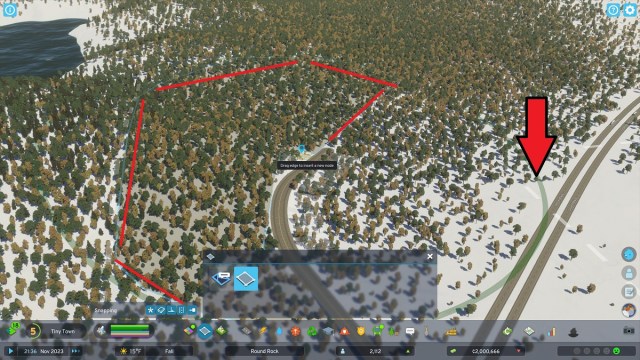
Follow these steps to place your first forestry-specialized industry buildings in Cities: Skylines 2:
- Open the Zones menu in the bottom toolbar.
- Click the Specialized Industry tab on the far right.
- Select the log icon in the middle of the pane that appears.
Before doing anything else, go to your forest. With the forestry building selected, hover over the forest. You’ll see how much lumber you’ll produce based on the placement. Zoom out here to see a green circle surrounding your building. This indicates the range of the building. We want as much forested land in this circle as possible.
Once you’ve pinpointed where you want to place the structure, place a road leading from your network to the location. I’ve found it doesn’t matter the road size. Often, a four-lane road is overkill since delivery vehicles like semis don’t clog roads as they do in Cities: Skylines. I often opt for a two-lane avenue or even a dirt road to save money.
Place the building. Next, make the area as large as it can be, reaching out to the edges of the circle. This area marks how much forest can be harvested. The larger the area, the more production you’ll have and the more employees a building can employ. Only one of my forestry structures employs 72 Cims and produces 176 tons of lumber per month.
How Does Forestry Work in Cities Skylines 2?
In Cities: Skylines, setting up a forestry industry was a much more involved process, requiring much more forethought and planning. Creating districts was essential, as was creating well-designed road networks to alleviate heavy traffic from trucks importing and exporting goods. Here, it’s far more streamlined in vanilla (and I’d argue a bit too streamlined).
I must stress how important this specialized manufacturing is to your regular industrial and commercial zones. Companies in both sectors need wood to produce goods, ranging from timber to furniture. If that’s not produced within a city, those businesses will import it from outside connections. That lowers their profitability, causing things like high rent. Further, you can also export any surplus you have.
How to Find Wood Natural Resources for Forestry
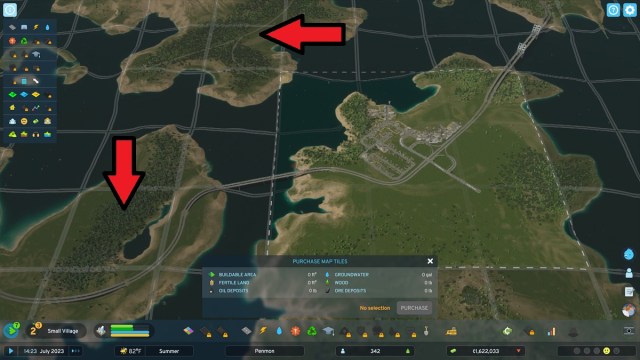
Finding wooded land for forestry is the easiest out of all the specialized industrial sectors because you can see it on the map without having to unlock the Natural Resources info panel (which becomes available at Milestone 3: Large Village).
- As you plan your city, press “M” to open the map and look for forested land.
- Denser areas are represented by a larger concentration of trees.
It’s very likely that you’ll need to buy more map tiles before you can add this production type to your supply chain. Very few maps have decent forestry options/areas in the starting tile. And though you can build in the starting tile, the buildings won’t be as efficient because of the usually lower forest density.
How to See and Understand Forestry Surplus and Deficit
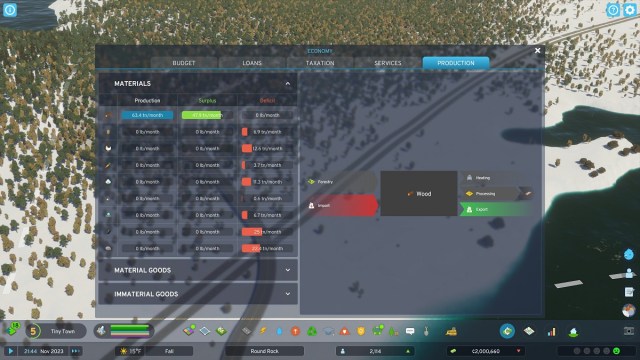
You can get an idea of how much lumber you’re producing or importing by going to the City Economy menu. Click the icon with the stack of money and cent sign in the bottom toolbar, just to the right of the bulldozer icon. From there, click the Production tab (which becomes available at Milestone 4: Grand Village) in the top right. Alternatively, you can press “Z” to open the City Economy window.
Lumber is the top option in the Materials drop-down, which opens automatically when entering this tab. You’ll see how many tons you’re producing each month. Next to that is a green bar showing your surplus in tons, and next to that is a red bar showing your deficit in pounds/kilograms.
- Before building any specialized forestry industry buildings, you’ll be at a deficit equal to the number of businesses that need wood products. These appear randomly in your industrial and commercial zones.
- Once you build forestry buildings, you’ll see the production bar fill and list a number that correlates to your monthly production. You’ll also see your deficit bar/number decrease.
- If you produce enough wood, it will empty and go to zero. Additionally, you may see your surplus bar increase if you produce more than you need. In that case, you’ll begin to sell timber.
You can see how much of your exports/imports are lumber products in a pie graph by clicking the Info Views block in the top left corner of the screen (the blue block with the circle and “I”). You can also press “I” to open this pane. From there, click the white arrow in the fifth row. This opens the Outside Connections pane, giving you a quick look at your import and export percentages per good.
Note that all of the numbers in the Production tab and Outside Connections pane will fluctuate based on demand. This is influenced by how many production buildings you have, how many local businesses need the goods produced, and the demand from outside connections.
What is Forestry Utilization Rate and Renewal Rate?
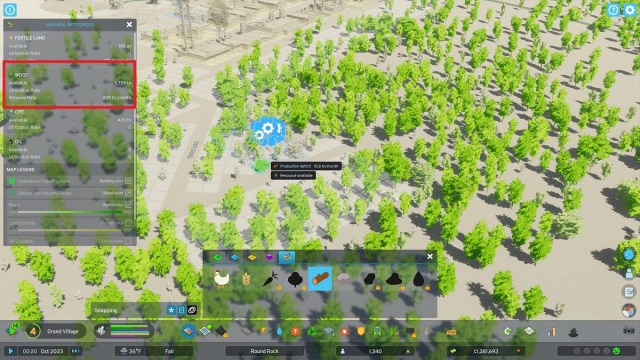
You can see utilization rate and renewal rate in the the Info View by selecting Natural Resources. Essentially, utilization rate means how much forest you’re harvesting currently, while renewal rate means how fast the forests renew themselves. If you use more than is renewed, your industry will suffer.
However, I yet to run into that type of problem on any map. Often, I produce more than enough lumber for my needs before getting close to the renewal rate. Regardless, you can renew forests by making a lumber yard’s area smaller or placing trees with the terraforming tools, though the latter’s effect is negligible at best.
What is the Best Forestry Map in CS2?
These are the best maps for forestry in Cities: Skylines 2 with the most forested acres:
- Lakeland: 0.4k tn.
- River Delta: 0.4k tn.
- Windy Fjords: 0.4k tn.
I specifically like Lakeland because of the densely wooded area northwest of the starting tile. It’s near a highway, which provides a perfect outside connection and delivery route once I unlock highways. It’s also possible to build a bridge over the river to access materials early, giving access to a large production area with spending fewer map points. Finally, the area fits well within the area of the forestry building, maximizing efficiency.
Another good option that allows for increased efficiency within the area of effect is Barrier Island, which has a forest to the northwest of the starting tile. The overall tonnage is lower here at 0.3k tn, but again, I don’t find that I often need more than one specialized building to meet my needs.
Can You Make Your Own Forested Area for Production?
Not really. Though you can place trees with the landscaping tool, it only affects the tonnage harvested per month marginally. It’s much more efficient to find a densely forested piece of land.
Does Forestry Cause Pollution in Cities Skylines 2?
No: forestry doesn’t cause pollution in Cities: Skylines 2. The service building in vanilla is as eco-friendly as it can be. However, it does produce medium noise pollution, radiating out in a roughly 10-block radius. Don’t build near any residential neighborhoods.
That does it for how to set up a forestry industry in Cities: Skylines 2. For more tips and tricks, such as how to dezone areas (lumberyards not included), click the link or head over to our CS2 guides page.

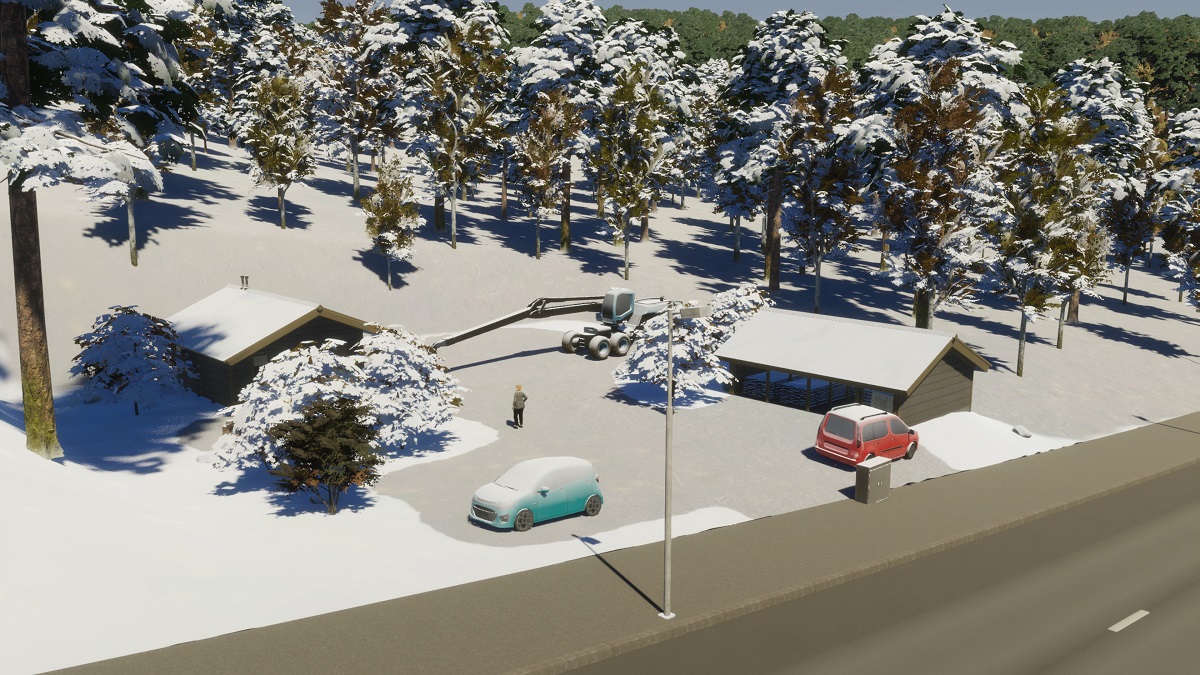





Published: Nov 2, 2023 11:22 am